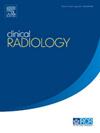An observational study of the prevalence of classic metaphyseal fractures in children with osteogenesis imperfecta in the first two years of life
IF 2.1
3区 医学
Q2 RADIOLOGY, NUCLEAR MEDICINE & MEDICAL IMAGING
引用次数: 0
Abstract
AIM
Classic metaphyseal fractures are highly suggestive of inflicted injury. Osteogenesis imperfecta (OI) is an important differential in infants presenting with unexplained fracture(s), and some argue that classic metaphyseal fractures occur accidentally in children with OI. This study sought to assess the prevalence of classic metaphyseal fractures in children with OI during the first 2 years of life.
MATERIALS AND METHODS
This was a retrospective observational cohort study of children with OI less than 2 years of age between 01/01/2010 and 31/12/2021. Radiographs and reports were reviewed by two observers. The site and type of fractures were recorded along with other radiological features of OI. Descriptive and inferential statistics were used to analyse the results.
RESULTS
There were 109 eligible patients (53 female) who had a total of 3,142 images (1,949 images in those less than 1 year old). There were 87 patients (79.8%) with a total of 462 long bone fractures, of which 386 (83.5%) were diaphyseal and 76 (16.5%) were at the junction of the diaphysis and metaphysis. No classic metaphyseal fractures were identified.
CONCLUSION
The absence of classic metaphyseal fractures in this large cohort suggests that OI is rarely, or not at all, associated with such fractures. However, metadiaphyseal fractures, reflecting bone fragility, are common; distinction should be made between ‘classic metaphyseal’ and ‘metadiaphyseal’ fractures to facilitate clinical decision-making. The unspecified term ‘metaphyseal fracture’ should be avoided. Children less than 2 years old with OI and classic metaphyseal fractures should be thoroughly investigated to exclude inflicted injury.
一项关于两岁前成骨不全儿童典型干骺端骨折发生率的观察性研究
典型的干骺端骨折高度提示外伤。成骨不全(Osteogenesis imperfecta, OI)是婴儿出现不明原因骨折的重要鉴别指标,一些人认为典型的干骺端骨折是在成骨不全儿童中意外发生的。本研究旨在评估成骨不全儿童2岁前典型干骺端骨折的发生率。材料与方法这是一项回顾性观察队列研究,研究对象为2010年1月1日至2021年12月31日期间2岁以下的成骨不全儿童。两名观察员审查了x光片和报告。记录骨折的位置和类型以及其他OI的影像学特征。采用描述性统计和推理统计对结果进行分析。结果符合条件的患者109例(女性53例),共扫描图像3142张(1岁以下患者1949张)。87例(79.8%),共462例长骨骨折,其中骨干骨折386例(83.5%),干骺端骨折76例(16.5%)。未发现典型的干骺端骨折。结论:在这个大的队列中,没有典型的干骺端骨折,这表明成骨不全很少或根本不与此类骨折相关。然而,反映骨脆性的干骺端骨折是常见的;应区分“典型干骺端”和“干骺端”骨折,以便于临床决策。应避免使用未明确的术语“干骺端骨折”。小于2岁的成骨不全和典型干骺端骨折的儿童应彻底检查以排除造成的损伤。
本文章由计算机程序翻译,如有差异,请以英文原文为准。
求助全文
约1分钟内获得全文
求助全文
来源期刊

Clinical radiology
医学-核医学
CiteScore
4.70
自引率
3.80%
发文量
528
审稿时长
76 days
期刊介绍:
Clinical Radiology is published by Elsevier on behalf of The Royal College of Radiologists. Clinical Radiology is an International Journal bringing you original research, editorials and review articles on all aspects of diagnostic imaging, including:
• Computed tomography
• Magnetic resonance imaging
• Ultrasonography
• Digital radiology
• Interventional radiology
• Radiography
• Nuclear medicine
Papers on radiological protection, quality assurance, audit in radiology and matters relating to radiological training and education are also included. In addition, each issue contains correspondence, book reviews and notices of forthcoming events.
 求助内容:
求助内容: 应助结果提醒方式:
应助结果提醒方式:


